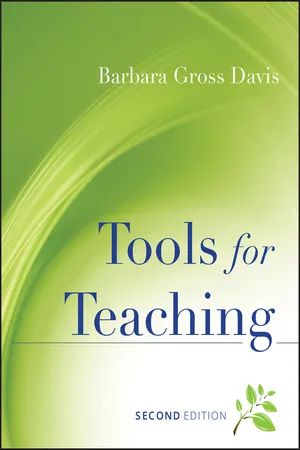
- English
- ePUB (mobile friendly)
- Available on iOS & Android
eBook - ePub
Tools for Teaching
About this book
This is the long-awaited update on the bestselling book that offers a practical, accessible reference manual for faculty in any discipline. This new edition contains up-to-date information on technology as well as expanding on the ideas and strategies presented in the first edition. It includes more than sixty-one chapters designed to improve the teaching of beginning, mid-career, or senior faculty members. The topics cover both traditional tasks of teaching as well as broader concerns, such as diversity and inclusion in the classroom and technology in educational settings.
Frequently asked questions
Yes, you can cancel anytime from the Subscription tab in your account settings on the Perlego website. Your subscription will stay active until the end of your current billing period. Learn how to cancel your subscription.
No, books cannot be downloaded as external files, such as PDFs, for use outside of Perlego. However, you can download books within the Perlego app for offline reading on mobile or tablet. Learn more here.
Perlego offers two plans: Essential and Complete
- Essential is ideal for learners and professionals who enjoy exploring a wide range of subjects. Access the Essential Library with 800,000+ trusted titles and best-sellers across business, personal growth, and the humanities. Includes unlimited reading time and Standard Read Aloud voice.
- Complete: Perfect for advanced learners and researchers needing full, unrestricted access. Unlock 1.4M+ books across hundreds of subjects, including academic and specialized titles. The Complete Plan also includes advanced features like Premium Read Aloud and Research Assistant.
We are an online textbook subscription service, where you can get access to an entire online library for less than the price of a single book per month. With over 1 million books across 1000+ topics, we’ve got you covered! Learn more here.
Look out for the read-aloud symbol on your next book to see if you can listen to it. The read-aloud tool reads text aloud for you, highlighting the text as it is being read. You can pause it, speed it up and slow it down. Learn more here.
Yes! You can use the Perlego app on both iOS or Android devices to read anytime, anywhere — even offline. Perfect for commutes or when you’re on the go.
Please note we cannot support devices running on iOS 13 and Android 7 or earlier. Learn more about using the app.
Please note we cannot support devices running on iOS 13 and Android 7 or earlier. Learn more about using the app.
Yes, you can access Tools for Teaching by Barbara Gross Davis in PDF and/or ePUB format, as well as other popular books in Education & Education Teaching Methods. We have over one million books available in our catalogue for you to explore.
Information

PART I
Getting Under Way
1
Designing or Revising a Course
In designing or revising a course, faculty must consider what material to teach, how best to teach it, and how to ensure that students are learning what is being taught. Many instructors, hoping to impart to students everything they know about a subject, attempt to include far too much material. Indeed, one of the most difficult steps in planning a course is deciding which topics must be excluded if the whole is to be manageable. The following suggestions are designed to help you make decisions about the content of your course, the structure and sequence of activities and assignments, the identification of learning outcomes, and the selection of instructional resources.
General Strategies
Let your decisions be guided by what you want your students to accomplish. Instead of thinking about the topics you want to teach, focus on learning outcomes: What do you want your students to be able to do after they have studied the material and completed their assignments? What knowledge, skills, attitudes, and “habits of mind” do you want your students to acquire during the semester? (Sources: Diamond, 1998; Fry et al., 2003; Ramsden, 2003; Suskie, 2004)
Apply principles that will enhance students’ learning and intellectual development. The most important of these principles are discussed in Chapter 29, “Helping Students Learn.” For example, you will want to think about how to provide your students with opportunities for active learning and for peer interaction, how to organize and communicate the material, what constitutes a reasonable workload, and how you and your students will monitor and assess their progress. (Source: Donnelly and Fitzmaurice, 2005)
Design or revise your course with principles of universal design in mind. Universal design is based on the premise that barrier-free, inclusive design benefits everyone—those with and without disabilities—and thereby eliminates or reduces the need for assistance and accommodation (see Chapter 6, “Students with Disabilities”). In college classes, instructors can
- use a variety of instructional methods
- offer students multiple ways to demonstrate mastery
- use technology to increase accessibility
- provide options for participation and presentations
- invite students to make their needs known
Aim for alignment of course elements. Alignment means that learning outcomes, instructional activities, and assessments of student learning are consistent and reinforce each other. Research shows that learning is improved when there is alignment among what instructors intend to teach, what they actually teach, and what they test. (Sources: Whetten, 2007; Wulff, 2005)
Preliminary Information Gathering
When preparing to teach a course for the first time, talk with faculty who have taught it previously. Ask your colleagues for their syllabus, course Web pages, instructional resources, list of assignments and papers, and old exams. Find out about the typical problems their students had with the material and any other difficulties the instructors encountered. Student evaluations of earlier offerings will also help you identify strengths and weaknesses of previous classes. If webcasts or podcasts of the course are available, view them as well.
When preparing a brand new course, review textbooks on the topic and materials or webcasts from similar courses at other universities. Current textbooks will give you a sense of the main themes, topics, and issues your course might address. Reviewing syllabi and webcasts or podcasts will let you see how other instructors approach the topics. Syllabi for introductory courses are often available from professional associations; some universities post syllabi online (see, for example, the MIT OpenCourseWare Web site).
Think about how your course fits into your department’s curriculum and sequences. Look at the syllabi for prerequisite courses and the courses for which your course serves as a prerequisite. The former will give you a sense of what your students will already know, and the latter will help you identify the knowledge and skills that your course is expected to address.
When revising a course you have taught, assemble all your old materials. You will want to look at your syllabus, textbooks and readings, handouts, exams, notes for each class session, and other instructional resources. Review the students’ end-of-semester evaluations to remind yourself of the course’s strengths and weaknesses. Examine your materials in light of students’ comments, new developments in the field, and your own changing interests.
Consider the characteristics of your students. As you plan your course, think about your prospective students: What range of knowledge, skills, and attitudes might they bring to the course? Will they be new to the field, potential majors, majors, or nonmajors? What courses have they already completed? What preconceptions and misperceptions might they have? Will all or most of your students be just out of high school, or older and more mature? Will some be part-time students who have work or family responsibilities? Will they be living on campus or will they commute?
Identify constraints on the course. As you begin to design the course, ask yourself, How many hours are available for instruction? How many students will be enrolled? Will you have lab assistants, graduate student instructors, or readers? What sorts of technology will be available in the classroom? Will there be opportunities for fieldwork or internships? What barriers or obstacles might detract from your students’ learning?
Deciding What You Want to Accomplish
Think beyond this semester. Imagine yourself overhearing a group of graduating seniors who have taken your course and are discussing why it was among the most valuable courses they had ever taken. What would they be saying about your course? Or imagine that several of your students will become local or national power brokers, or that half of them will drop out of school before graduation. What would you like the legacy of your course to be for these students? What will distinguish students who have taken this course from those who have not? (Sources: Bergquist and Phillips, 1977; Fink, 2003; Wiggins and McTighe, 2005)
Use taxonomies to help identify a range of learning outcomes. Bloom’s classic Taxonomy of Educational Objectives (1956) outlines six levels of cognitive processing: Knowledge, Comprehension, Application, Analysis, Synthesis, and Evaluation. Although Bloom’s taxonomy oversimplifies how learning occurs, and research has not supported its hierarchical structure, it provides a useful starting point for defining learning outcomes that go beyond the memorization of facts. Applying new research on learning and cognitive development to Bloom’s taxonomy, Anderson and Krathwohl (2001) offer a matrix that matches four types of knowledge (Factual, Conceptual, Procedural, and Metacognitive) against each of six cognitive processes (Remember, Und...
Table of contents
- Cover
- Table of Contents
- Title
- Copyright
- PREFACE
- Acknowledgements
- CREDITS
- THE AUTHOR
- Dedication
- PART I - Getting Under Way
- PART II - Responding to a Changing Student Body
- PART III - Discussion Strategies
- PART IV - The Large-Enrollment Course
- PART V - Alternatives and Supplements to Lectures and Discussion
- PART VI - Enhancing Students’ Learning and Motivation
- PART VII - Strengthening Students’ Writing and Problem-Solving Skills
- Part VIII - Testing and Grading
- PART IX - Presentation Technologies
- PART X - Evaluation to Improve Teaching
- PART XI - Teaching Outside the Classroom
- PART XII - Finishing Up
- INDEX
- End User License Agreement